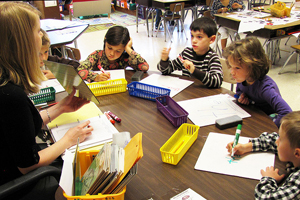Earlier this month, the What Works Clearinghouse (WWC) released a new report on the effectiveness of Peer-Assisted Learning and Literacy Strategies (PALS) programs. 
In reviewing more than 40 studies, the WWC concluded that PALS programs may have positive effects on the development of elementary school students’ alphabetics skills, although discernible effects regarding the programs’ influence on the fluency and comprehension skills of beginning readers have yet to be established.
The WWC report evaluates the influence of two programs, both of which are represented by the PALS acronym: the Peer-Assisted Learning Strategies and Peer-Assisted Literacy Strategies programs. Both programs are anchored around pair-based reading activities, with the intent of improving the reading accuracy, comprehension and fluency skills of early elementary school children, with each program emphasizing similar learning strategies, such as multi-student passage reading, paragraph summarizations and content prediction relays.
The PALS programs are generally used as supplements to schools’ primary reading curriculum, and are tailored around the strengths and weaknesses of individual students. In most iterations of the program, teachers assign students to two-person groups in which one student is generally proficient in one reading area, while his or her partner is proficient at another. Typically, students take turns being “tutor and tutee” with their partner, and are often given the opportunity to hone their reading skills with other students. Most PALS activities are about half an hour long, and are conducted three to four times per week in a majority of participating schools.
The WWC report zeroes in on findings from three randomized controlled trials, two of which meet WWC evidence standards and one that meets the organization’s criteria for evidence standards with reservations. The three studies evaluated by the WWC – conducted in 2001, 2005 and 2008, respectively – entailed research in four states, encompassing a total population of more than 3,000 students across 80 schools from Minnesota to south Texas.
Ultimately, the WWC deemed the influence of PALS programs to be “medium to large” in the development of students’ alphabetic skills, with a much smaller “extent of evidence” regarding the programs’ effectiveness in developing children’s fluency and comprehension skills.
The alphabetic domain – which was examined in two studies conducted three years apart – assessed the outcomes for first graders in several categories, including spelling, word identification and rapid letter naming.
In analyzing the effectiveness of such programs on the alphabetic domain, the WWC report found that one study from 2008 had demonstrated statistically significant positive effects, whereas an earlier study from 2005 demonstrated indeterminate effects stemming from PALS programs. As the two studies encompassed more than 75 schools and over 3,000 students, the WWC report considers the evidence of PALS influence in the alphabetic development to entail “a positive effect with no overriding contrary evidence.”
An analysis of a 2005 study, however, demonstrated that there were no “affirmative evidence of effects” regarding the influence of PALS programs in the development of children’s reading fluency skills, with a study of eight schools and more than 40 students exhibiting no statistically significant effects in the Near-Transfer Fluency and Far-Transfer Fluency outcomes of first graders.
Additionally, WWC analysis of two studies pertaining to the influence of PALS programs on reading comprehension skills turned up inconclusive results, with the report declaring a “small extent of evidence” in examining findings from 13 schools and more than 170 children.
The What Works Clearinghouse, an initiative of the United States Department of Education’s Institute of Education Sciences, was founded in 2002, with the intent of providing “a central and trusted source of scientific evidence” regarding educational techniques and programs.
Photo via Flickr user woodleywonderworks






























